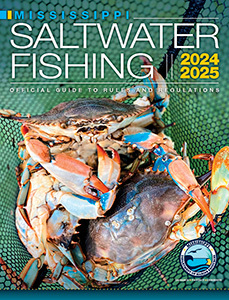Boating Information
Boating Education Course
- Any person born after June 30, 1980, must pass a boating education course approved by the Mississippi Department of Wildlife, Fisheries and Parks to legally operate a vessel.
- Any person under 12 years old must be accompanied by someone who is at least 21 years old when operating a motorboat or a personal watercraft.
- The boating education certification card must be carried onboard the vessel whenever the vessel is operated by someone required to have a certificate.
The Mississippi Department of Marine Resources Marine Patrol offers free approved boating education classes. To register, visit mdwfp.com/law-enforcement/boater-education.
Required Equipment
Personal Flotation Devices
- All vessels must carry one wearable U.S. Coast Guard–approved Personal Flotation Device for each person on board.
- Vessels 16 feet or longer - must have one U.S. Coast Guard-approved Type IV PFD readily available on board.
- Vessels less than 26 feet in length - Children 12 years old and younger must wear a U.S. Coast Guard–approved Type I, II or III PFD whenever underway.
- Personal water craft (PWC) - Each person riding on or being towed behind must wear a Type I, II or III US Coast Guard-approved PFD in Mississippi waters south of Interstate 10.
- PFDs must be
- In good and serviceable condition.
- Readily accessible, which means you can put the PFD on quickly in an emergency.
- Proper size for the intended wearer. Sizing for PFDs is based on body weight and chest size.
Navigation Lights
Navigation lights must be displayed between sunset and sunrise and during periods of restricted visibility. These lights help boaters determine which vessel is the give-way boat when encountering each other at night.
Fire Extinguisher
All vessels are required to have a Type B fire extinguisher on board if one or more of the following conditions exist:
- Closed compartments under seats where portable fuel tanks may be stored
- Closed storage compartments in which flammable or combustible materials may be stored
- Closed living spaces
- Permanently installed fuel tanks
Approved types of fire extinguishers are identified by the following marking on the label— “Marine Type USCG Approved”—followed by the type and size symbols and the approval number.
Sound Producing Devices
- Vessels less than 39.4 feet are required to make an efficient sound (horn, whistle or bell) to signal their position in periods of reduced visibility.
- Athletic whistlers are not acceptable sound-producing devices for vessels over 39.4 feet long.
- Vessel operators are to carry a horn or whistle capable of a four-second blast audible for one-half mile for all boats.
Visual Distress Signals
- Vessels less than 16 feet must be equipped between sunrise and sunset
- Vessels more than 16 feet must be equipped always
- Federally controlled waters – ALL VESSELS must be equipped with US Coast Guard-approved day and night signals.
Personal Water Craft and Towing Requirements
- The PWC must be equipped with a self-circling device or lanyard type ignition-safety switch attached to the operator’s clothing or PFD.
- May not be operated at an excessive speed within 100 feet of another occupied vessel, except for a crossing situation or overtaking in accordance with the navigation rules.
- May not jump or attempt to jump the wake of another vessel within 100 feet of that vessel.
- May not follow within 100 feet of a water skier.
- A person older than the age of 10 must be present, in addition to the driver, when towing a person on water skis, surfboard or similar device.
- When towing a person, PWCs must be rated for at least three people (the driver, observer and person being towed).
For marine emergencies, call 1-844-WE-R-MDMR (937-6367).

